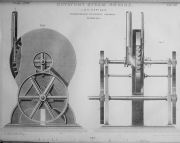Difference between revisions of "J. and E. Harthan"
| Line 1: | Line 1: | ||
[[Image:JD 2020 Harthan1.jpg|thumb|Impulse turbine (form The Practical Mechanic's Journal, 1 October 1858]] | |||
John and Ezra Harthan of Timbersbrook, Congleton, Cheshire | John and Ezra Harthan of Timbersbrook, Congleton, Cheshire | ||
Revision as of 23:49, 19 January 2020
John and Ezra Harthan of Timbersbrook, Congleton, Cheshire
Made small impulse turbines for use with steam or air. Described and illustrated in The Practical Mechanic's Journal, 1 October 1858. One, weighing just 126 lbs, was supplied to Edwin Scragg of Buglawton, near Congleton, where it drove three slide lathes, a planing machine, shaping machine, two drilling machines, and a blast fan. Other turbines were at work at Harthan's silk mills and in the machine works of Mr. Lowndes at Congleton.
1860 'TO ADMIRERS OF MECHANICAL ART, AND MANAGERS OF MECHANICS' INSTITUTIONS. —TO BE SOLD BY PRIVATE TREATY, a SCIENTIFIC EXHIBITION of ANCIENT and MODERN STEAM ENGINES.
The Exhibition consists of a revolving platform, with steam boiler fixed upon its centre. The engines are arranged round the boiler in chronological order, and can all worked at once, or separately, each being distinctly supplied with steam or air. The Engines are :
No. 1.— THE AEOLIPILE.—This is the first invention in steam power on record, invented and described in the works of Hero, of Alexandria, 130 years before the birth of Christ.
No. 2.—BRANCA'S STEAM WHEEL.—This engine was invented and described in a work published in Rome in 1629 by Giovanni Branca, an Italian.
No. 3.-WATT'S BEAM ENGINE.- With all its complex machinery, which during the last half century has caused such rapid progress in motive power.
No. 4.—DIRECT ACTING ENGINE.— This is like the third in principle, but dispensing with the beam and its connections. No. 5.— HARTHAN'S PATENT.— This engine combines all the principles the mechanical force steam, viz., impact, pressure, and re-action, it weighs only 126lbs., and is capable of doing the work of five horses, requiring not more than half the fuel used by other engines of the same power. It stands only 20 inches high, on a base plate of 14 inches by 13 inches. It is admitted to be the most marvellous production of the age, requiring neither cylinder, piston, valve, packing, connecting rod, beam, crank, nor flywheel, but consists simply of a plate wheel enclosed a brass case, and fixed upon a shaft free to revolve on bearings, and geared to a counter shaft by toothed wheels.
No. 6.— HARTHAN'S PATENT (Interior) .- This is intended illustrate the principle and workings of Harthan's engine. It is worked by a jet of air for the convenience of inspection.
For particulars, apply to Joseph Hackney, America-street, Tunstall, Staffordshire Potteries.'[1]
See Also
Sources of Information
- ↑ Staffordshire Advertiser - Saturday 24 November 1860


